How to Declutter Your Bedroom: A Comprehensive Guide
Your bedroom should be a sanctuary, a place for rest and rejuvenation.
However, it often becomes a catch-all for clothes, books, and miscellaneous items, leading to a cluttered and stressful environment.
Decluttering your bedroom is not just about tidying up; it’s about creating a more peaceful and functional space that supports your well-being.
This comprehensive guide will walk you through a step-by-step process to declutter your bedroom effectively.
1. Preparation is Key

Before you even begin to remove items, take some time to prepare. This will make the process more organized and less overwhelming.
- Schedule Time: Dedicate a specific block of time to decluttering. Avoid trying to do it all at once, as this can lead to burnout. Break it down into smaller sessions if necessary.
- Gather Supplies: Collect essential items like trash bags, donation boxes, cleaning supplies (dust cloths, all-purpose cleaner, vacuum), and storage containers (if you plan to reorganize items you keep).
- Define Your Vision: Think about how you want your bedroom to look and feel once decluttered. Having a clear picture in mind will help you stay motivated and focused. Do you want a minimalist aesthetic, a cozy retreat, or a highly organized space?
- Set Ground Rules: Decide on some basic rules for yourself. For example, you might decide that everything must have a designated place or that you will be ruthless in letting go of items you no longer use or need.
2. The Sorting Process: Conquer One Area at a Time

Instead of tackling the entire room at once, focus on decluttering one area at a time. This makes the task feel more manageable and allows you to see progress quickly. Common areas to address include:
- The Closet: This is often a major source of clutter.
- Empty it out: Take everything out of your closet and place it on your bed or floor. This allows you to see the full extent of your wardrobe.
- Sort into categories: Create three piles: “Keep,” “Donate/Sell,” and “Trash.”
- Evaluate each item: Ask yourself the following questions for each piece of clothing:
- Have I worn this in the last year? (Seasonal items are an exception).
- Does it fit comfortably?
- Is it in good condition (no stains, tears, or missing buttons)?
- Do I genuinely like how I look and feel in it?
- Be honest: Don’t hold onto items “just in case” or out of guilt. If you haven’t worn it and don’t love it, it’s likely taking up valuable space.
- Consider storage solutions: Once you’ve decided what to keep, think about how to organize it effectively. Use matching hangers, shelf dividers, and storage bins to maximize space.
- The Dresser and Nightstands: These areas often accumulate smaller items.
- Empty each drawer/surface: Take everything out and lay it out so you can see it clearly.
- Sort and purge: Discard any trash, expired items, or things you no longer use. This might include old makeup, dried-up pens, or forgotten papers.
- Organize remaining items: Use drawer organizers or small containers to keep things tidy and separated. Designate specific drawers for different categories of items.
- Keep surfaces clear: Aim to keep the tops of your dresser and nightstands relatively clear. Limit yourself to essential items and a few decorative pieces.
- Under the Bed: This space can easily become a storage black hole.
- Pull everything out: See what’s hiding underneath.
- Be selective: Only store items under your bed that you occasionally need but don’t require daily access to. This might include off-season bedding, extra blankets, or storage containers with specific items.
- Use flat storage containers: Invest in under-bed storage containers to keep things organized and protected from dust.
- Other Areas: Don’t forget about bookshelves, corners, and any other areas where clutter might accumulate. Apply the same principles of emptying, sorting, and purging.
3. The Decision-Making Process: Letting Go
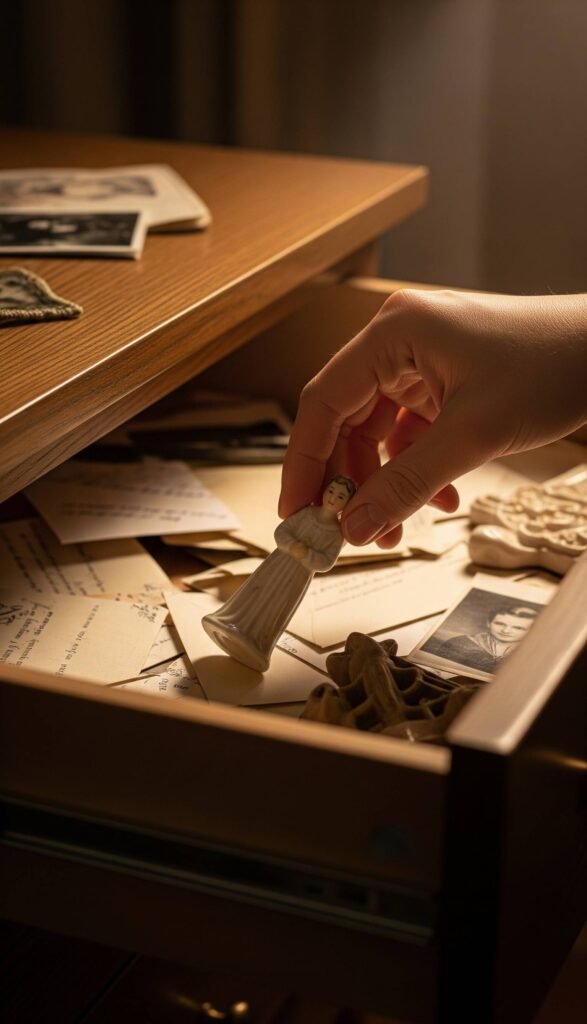
The most challenging part of decluttering is often deciding what to keep and what to let go of. Here are some guiding questions to help you make those decisions:
- Usage: Have I used this item in the last year? If not, and it’s not a sentimental or essential item, consider letting it go.
- Fit and Function: Does this item still fit me (clothing) or function as intended (broken electronics, etc.)? If not, it’s likely just taking up space.
- Value and Joy: Does this item bring me value or joy? If it doesn’t serve a purpose or make you happy, it might be time to say goodbye.
- Duplicates: Do I have multiple items that serve the same purpose? Consider keeping only the best or most frequently used one.
- Sentimental Items: These can be the hardest to declutter. Ask yourself:
- Why am I keeping this? What memories or feelings does it evoke?
- Do I need the physical item to preserve those memories, or would a photograph or a journal entry suffice?
- Am I keeping it out of obligation or genuine attachment?
- Consider creating a designated memory box for a few truly special items.
4. Removing the Clutter
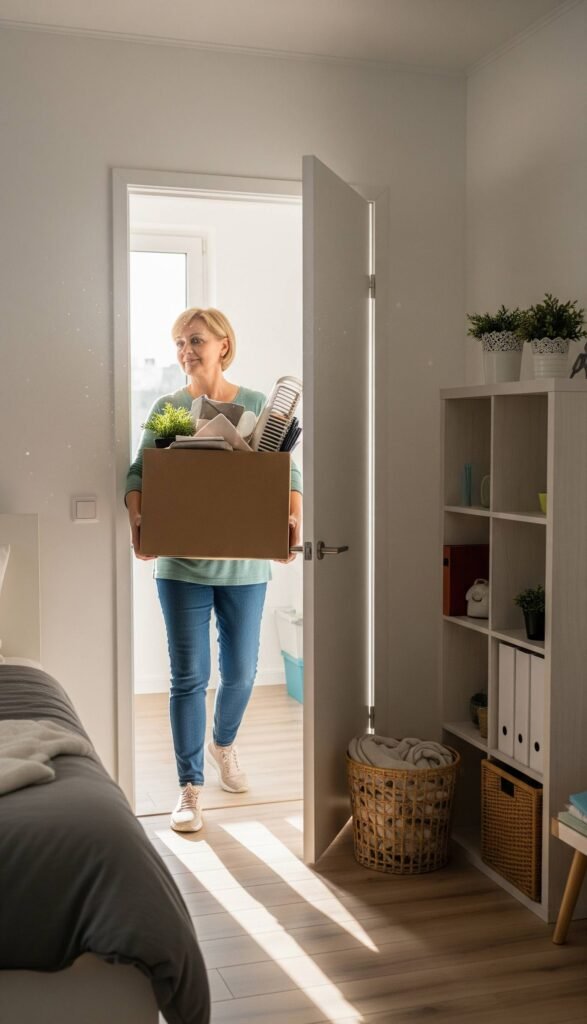
Once you’ve sorted through everything and decided what to let go of, it’s crucial to remove those items from your bedroom promptly.
- Donations: Gather your donation items and take them to a local charity or donation center as soon as possible.
- Selling: If you have items in good condition that you think you can sell, decide how you will do so (online marketplaces, consignment shops, etc.) and take action. Be realistic about the time and effort involved.
- Trash: Dispose of any trash or broken items properly.
- Relocate: If you find items that belong in other rooms, put them away immediately. Don’t let them create new piles of clutter.
5. Organizing What Remains
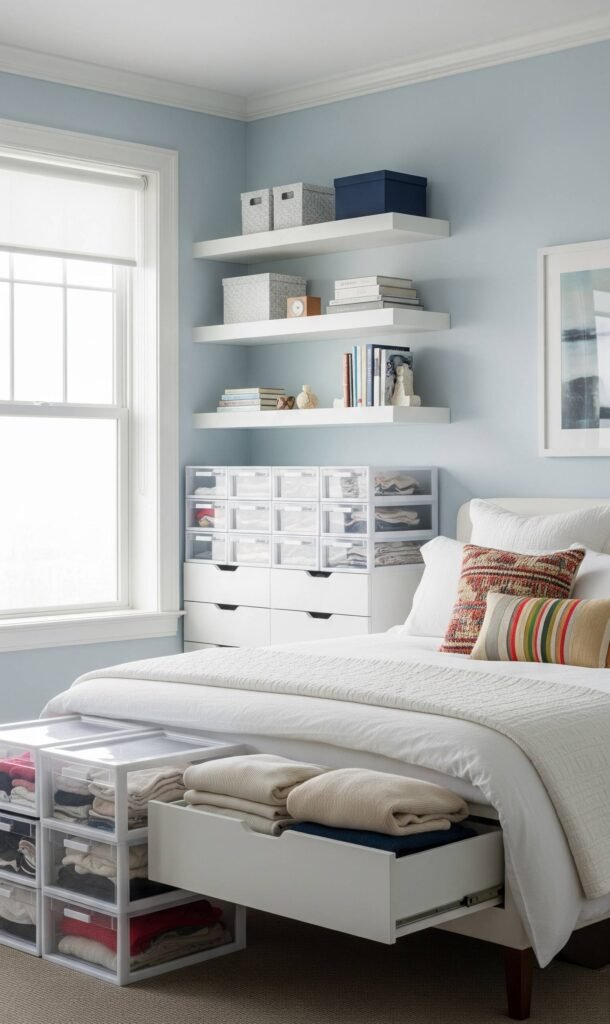
With the unwanted items gone, it’s time to organize what you’re keeping in a way that is functional and aesthetically pleasing.
- Designate a Place for Everything: The key to staying organized is ensuring that every item has a designated home. This makes it easier to put things away and find them later.
- Utilize Vertical Space: If your bedroom has limited floor space, make the most of vertical storage. Use shelves, wall-mounted organizers, and over-the-door hangers.
- Invest in Smart Storage Solutions: Consider using storage containers, drawer dividers, and baskets to keep smaller items contained and organized. Choose storage solutions that fit your style and the available space.
- Keep Surfaces Clear: Aim to keep flat surfaces like your dresser, nightstands, and desk as clear as possible. This creates a sense of calm and order.
- Organize by Category: Group similar items together. For example, keep all your socks together, all your books on the bookshelf, and all your toiletries in the bathroom.
6. Cleaning and Maintaining Your Decluttered Bedroom
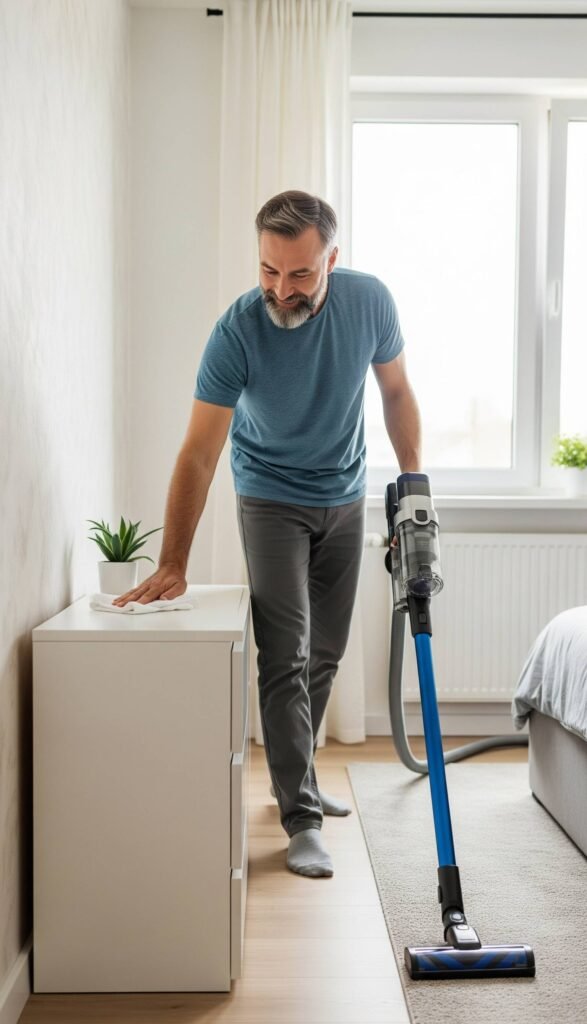
Once you’ve decluttered and organized, take the time to clean your bedroom thoroughly. Dust all surfaces, vacuum or mop the floor, and clean windows. A clean space will feel even more refreshing.
Maintaining a decluttered bedroom is an ongoing process. Here are some tips to help you stay organized:
- Put Things Away Immediately: Make it a habit to put items back in their designated place as soon as you’re finished using them.
- The One-In, One-Out Rule: For every new item you bring into your bedroom, try to remove one similar item. This helps prevent clutter from accumulating.
- Regular Tidying: Spend a few minutes each day tidying up your bedroom. This will prevent small messes from becoming overwhelming.
- Seasonal Decluttering: Consider doing a more thorough decluttering session seasonally, especially when transitioning your wardrobe between seasons.
- Be Mindful of What You Bring In: Before buying new items for your bedroom, consider whether you truly need them and where they will go.
7. The Benefits of a Decluttered Bedroom
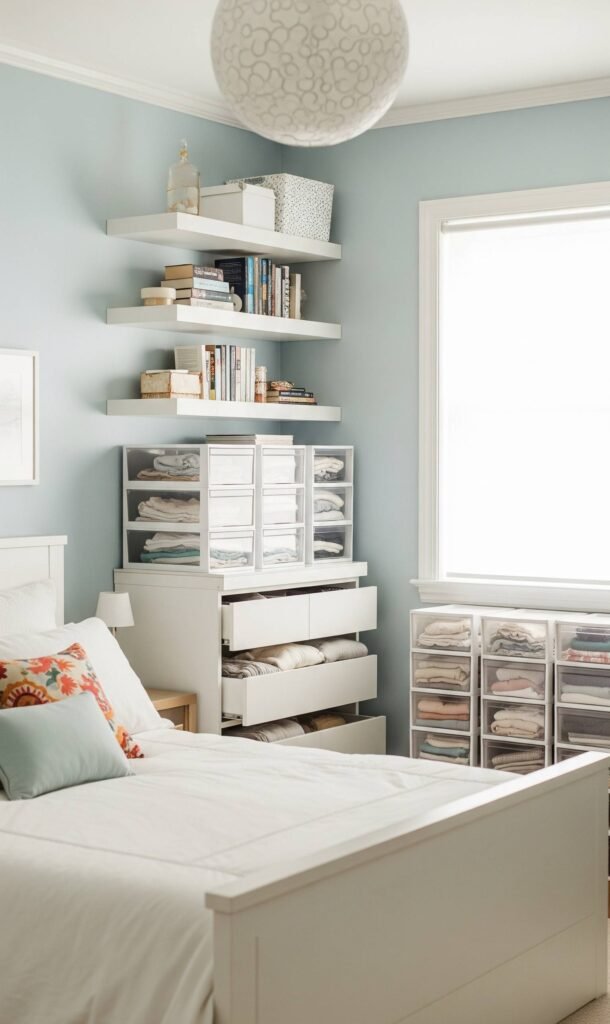
Decluttering your bedroom can have numerous positive impacts on your life, including:
- Improved Sleep: A clean and organized space can promote relaxation and reduce stress, leading to better sleep quality.
- Reduced Stress and Anxiety: Clutter can be visually overwhelming and contribute to feelings of stress and anxiety. A decluttered bedroom can create a more peaceful and calming environment.
- Increased Productivity: If you use your bedroom for work or other tasks, a decluttered space can help you focus and be more productive.
- Easier to Clean: A less cluttered room is easier and faster to clean.
- A Sense of Control: Decluttering can give you a sense of control over your environment, which can be empowering.
- More Enjoyable Space: A decluttered and organized bedroom can become a more enjoyable and relaxing space to spend time in.
Conclusion
Decluttering your bedroom is an investment in your well-being.
By following these steps and making decluttering a regular practice, you can create a peaceful and functional sanctuary that supports your rest and rejuvenation.
Remember to be patient with yourself and celebrate the progress you make along the way.
